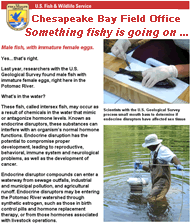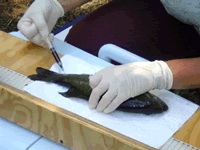|
Endocrine (Hormone) Disruptors
Research shows that endocrine disruptors may pose the greatest risk to offspring during prenatal and early postnatal development when organ and neural systems are developing. However, adverse consequences may not be apparent until much later in life.(1) In addition, endocrine disruptors may affect not just the offspring of mothers exposed to endocrine disruptors during pregnancy, but future offspring as well.(2)
are currently receiving the most attention. All three groups are needed to support life in mammals, including people, as well as amphibians, fish, birds, and reptiles. Possible effects on invertebrates also are receiving attention. DDT (Dichloro-Diphenyl-Trichloroethane) is probably the most notorious pesticide ever. DDT and its breakdown product DDE, like other organochlorines, have been shown to have xenoestrogenic activity; meaning they are chemically similar enough to estrogens to trigger hormonal responses in animals. More about DDT. In order to manage fish and wildlife populations for the American people, the Fish and Wildlife Service addresses the risks and effects of organic pollutants, metals and pesticides, including those that may possess endocrine activity, on the natural resources of the country. Links: DEQ News and Activities. November 29, 2006. Assessing Endocrine Disruption in Bass in the Potomac River Watershed. (includes links to KARE 11 Minneapolis/Saint Paul video clip on intersex fish in the Mississippi River and The Washington Post article - "Male Bass across Region found to be Bearing Eggs".)
U.S. Geological Survey: Oversight Hearing on "Ova-Pollution in the Potomac: Egg-Bearing Male Bass and Implications for Human and Ecological Health". Statement of Mark Myers, Director U.S. Geological Survey, Department of the Interior Before the House Committee on Government Reform. October 4, 2006 Center for Bioenvironmental Research of Tulane and Xavier Universities New Orleans, Louisiana: E.Hormones...Your Gateway to the Environment and Hormones... National Academy of Science Report: Read and Order Information- Hormonally Active Agents in the Environment - July 1999
Organization for Economic Co-operation and Development (OECD) - Endocrine Disrupter Testing and Assessment Society of Environmental Toxicology and Chemistry - Books on Endocrine Disruption U.S. Geological Survey National Water Quality Assessment Program - Pesticide National Synthesis Project US Geological Survey. Report on the potential for endocrine disruption in common carp from streams throughout the United States (1) Environmental Health Perspectives 103:83-87, 1995. Endocrinology 147 (6) Supplement S11-S17, 2006. | |||||||||
| Last Updated: October 20, 2008 | ||||||||||


